Hockey drills
- Make two rows of an equal number of players.
- Players take turns drifting toward the three double pawns.
- Arriving at the double pawns, do the herring trick three times in a row and then flatten the ball on goal.
Herring trick:
- You play the ball to the right of the double pawn and pass it yourself to its left.
- Make sure you have control of the ball again before the next double pawn.
- So push the ball in a controlled manner.
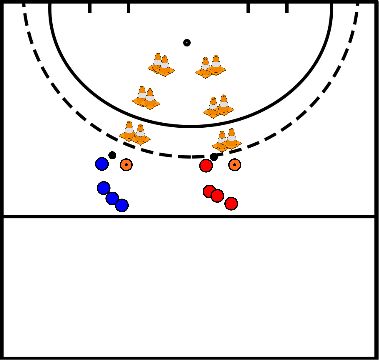
Party with four goals.
- The coach makes two equal teams.
- Each team defends two goals.
- It is allowed to play field hockey behind goal, but scoring is only allowed at the front.
Points of attention:
- Play with the 3 second rule; take the ball quickly after a foul. Takes longer than 3 seconds, free hit for the opposing team.
- If it is crowded on one side of the field, move the ball at pace to the other side where there is more space.
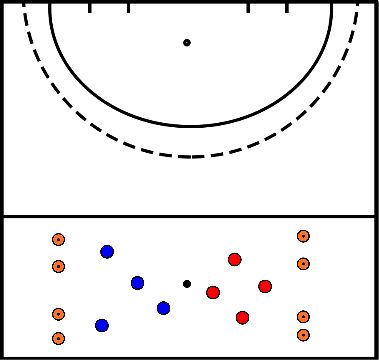
Party with four goals.
- The coach makes two equal teams.
- Each team defends two goals.
- It is allowed to play field hockey behind goal, but scoring is only allowed at the front.
Points of attention:
- Play with the 3 second rule; take the ball quickly after a foul. Takes longer than 3 seconds, free hit for the opposing team.
- If it is crowded on one side of the field, move the ball at pace to the other side where there is more space.
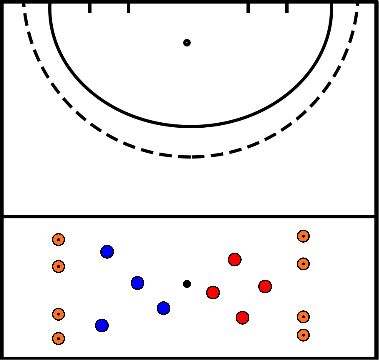
Relay
- Create two equal teams.
- Start the relay at the coach's signal.
- The player slaloms around the pawns -both ball and body around the pawns- and rounds on goal -push or flush-.
- If the player scores, he may immediately sprint back and tap the next player.
- If the player misses, he must take a detour via the blue pawn -on the side of the field- and then sprint back and tap the next player.
- When it's your turn, you sit down on the ground.
- Depending on the number of players, you can also choose to have all players take 2 or 3 turns.
- The next player may not start until he is tapped by the player in front of him.
- The team that has all players on the ground first wins the relay.
- There are different types of slalom to apply in this exercise:
- Normal slalom
- Slalom in which the player's body and ball are to the left or right of the row of pawns.
- Slalom where the ball is to the left of the row of pawns and the body is to the right.
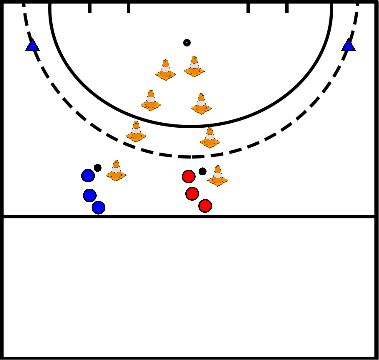
Put out as many times as there are players:
- Each player has their own pawn.
- They play 1-1 with the person opposite them.
- The ball is in the middle.
- At the whistle, they start trying to tap the other person's pawn.
- After a certain time, blow the whistle.
- Player who won moves one space to the right on the loser 1 to the left.
- In case of a tie; stone paper scissors.
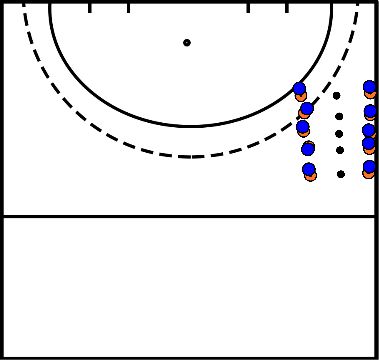
- There is a box of 4 different colored pawns.
- The players start 5 to 10 meters away from the box (in this case the 23 meter line).
- The trainer calls out a number of colors in succession.
- E.g. Blue red orange blue.
- The players then run to those pawns and then back to where they started.
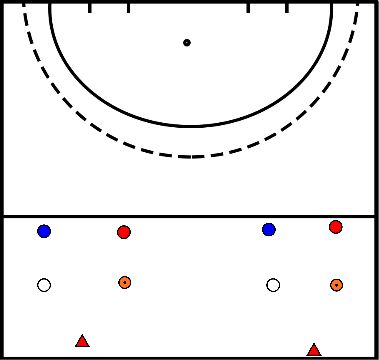
- You start at the 25 yard line.
- Gives a pass to the left.
- This player gives a pass to a player at the edge of the circle.
- Who drives something.
- Plays the ball into the circle and shoots at goal.
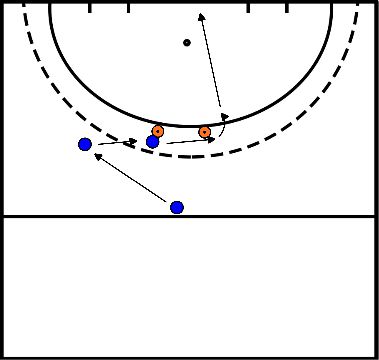
- On a quarter of a field, set out several exercises,
- The players can start directly after each other.
- From slalom,
- dummy,
- herring trick
- to a walk you can set out.
- So that during the warming up they can focus on all the techniques.
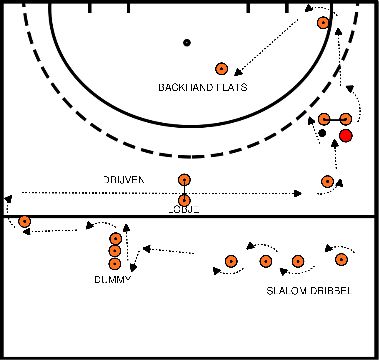
Two players continuously play the ball over until one student is so close to the goal that he can score in the goal.
- Variation 2-1 situation:
- Under pressure from the defender, the attackers must now play together and try to score.
- The defender can score a point by conquering the ball and then dribbling over the dead ball line.
- This is the short side without a goal.
- Putting down pawns.
- Make several situations, this depends on the amount of players you have.
- Dribble around the cones, at the last cone pass the ball back to the waiting team-mate, the team-mate also starts the slalom dribble again.
- Same as above, but now after the slalom score in the goal ( between two cones ), you take the ball out of the goal again yourself.
- Variation:
- Instead of shooting into the goal, give a cross after the last pawn to the person who is waiting at the pawn in front of the goal,
- This person shoots it into the goal and takes the ball back.
- The person who has passed stands on the spot in front of the goal to receive the ball.
- The players are divided into teams of 3.
- The game is played 3-3 on different fields.
- Players can score in 2 goals and therefore must also defend 2 goals.
- Variation:
- Take away the goal.
- Each team can only score on 1 goal, so they only have to defend 1 goal.
- This step is performed in different ways.
- The easiest way is to make a kind of sideways jump.
- It is also possible to make a cross pass, which brings you to the same height as the jump.







